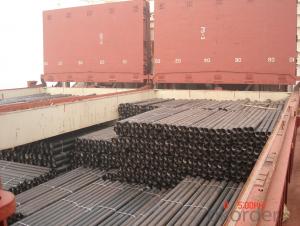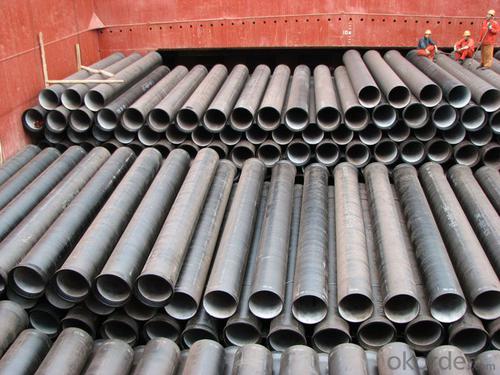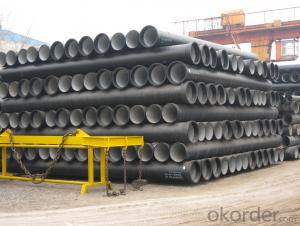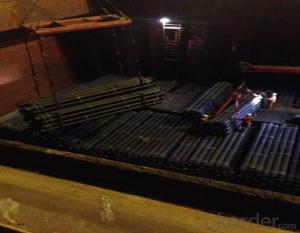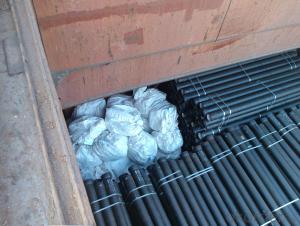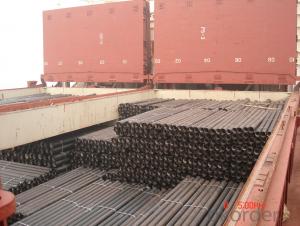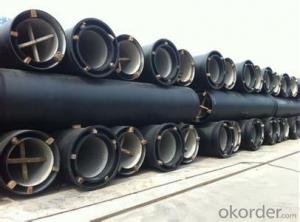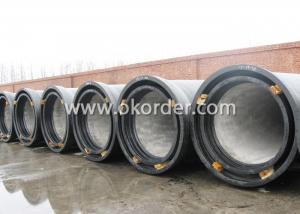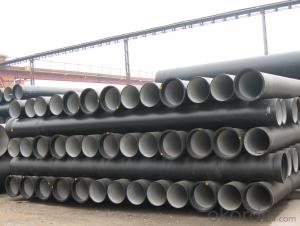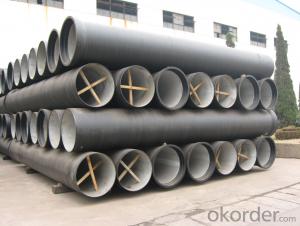DUCTILE IRON PIPE DN500 K8/C/K9
- Loading Port:
- China Main Port
- Payment Terms:
- TT OR LC
- Min Order Qty:
- -
- Supply Capability:
- -
OKorder Service Pledge
OKorder Financial Service
You Might Also Like
Specification:
1) The standard of pipe: ISO2531:1998, K9
2) Effective length: 6m
3) Inner cement line: Portland cement line as per ISO4179
4) Zinc coating: at least 130g/m2 as per ISO8179
5) Bitumen painting: at least 70um as per ISO8179
6) With 100% quantity of NBR ring, or SBR ring, or EPDM ring as per ISO4633
7) DN80mm-800mm
8) High strength, lighter than grey iron, good corrosion resistance, no furring, small flow resistance, easy fixing, long life tome about 100 yeas
9) Produced by Hangzhou chunfeng machine
10) Checked by automatic inspection equipment
11) Composition:
Chemical composition | | | | |||
Chemical composition | Ductile Cast Iron Pipe (%) | Grey iron pipe (%) | Steel pipe (%) | | | |
C | 3.5-4.0 | 3.2-3.8 | 0.1-0.2 | | | |
Si | 1.9-2.6 | 1.4-2.2 | 0.15-0.4 | | | |
Mn | 0.15-0.45 | 0.4-0.6 | 0.3-0.6 | | | |
P | ≤0.06 | ≤0.3 | 0.02-0.03 | | | |
S | ≤0.02 | ≤0.1 | 0.02-0.03 | | | |
Mg | 0.03-0.06 |
|
| | | |
12) Feature:
Mechanical properties | | | | |||
| Ductile Cast Iron Pipe | Grey Iron Pipe | Steel Pipe | | | |
Tensile Strength(Mpa) | ≥420 | 150-260 | ≥400 | | | |
Yield Strength(Mpa) | ≥300 | No Confirmation | No Confirmation | | | |
Bending Strength(Mpa) | ≥590 | 200-360 | ≥400 | | | |
Elongation (%) | ≥10 | Neglected | ≥18 | | | |
Brinell Hardness(HBS) | ≤230 | ≤230 | About 140 | | | |
13) T type mechanical joint
14) Packing: in bulk or container
- Q: Do ductile iron pipes require internal lining for potable water applications?
- Yes, ductile iron pipes do require internal lining for potable water applications. This is because the iron used in these pipes can react with the water and potentially contaminate it. Internal lining acts as a barrier between the water and the iron, preventing any chemical reactions and ensuring the water remains safe for consumption.
- Q: Can ductile iron pipe be repaired if it gets damaged?
- If ductile iron pipe sustains damage, it can indeed be repaired. The process of repair entails the removal of the damaged section and the subsequent substitution with a fresh section. Typically, a pipe cutter, a specialized tool, is utilized to achieve a seamless cut on both ends of the affected area. Once the damaged portion is extracted, a new section of ductile iron pipe is affixed securely by employing mechanical couplings or welding. To safeguard the pipe's integrity and functionality, it is crucial to adhere to the manufacturer's guidelines and industry standards during the repair procedure.
- Q: Can ductile iron pipes be repaired if they are damaged?
- Ductile iron pipes can undergo repairs if they sustain damage. The necessary repair method will depend on the extent of the damage. In instances where the pipe is cracked or has small holes, a repair clamp or a stainless-steel sleeve can be utilized to seal the affected area. These approaches offer a temporary solution, allowing water to continue flowing until a more permanent fix can be implemented. For more severe damage, such as significant cracks or broken segments, a complete replacement may be required. This process entails removing the damaged section of the pipe and installing a new piece. It is a specialized task that demands specific equipment and expertise, but it effectively restores the pipe's functionality. It is crucial to note that only trained professionals with experience in working with ductile iron should carry out the repairs. This ensures proper execution and safeguards the integrity and safety of the pipeline system. Regular inspection and maintenance of ductile iron pipes can aid in early detection of potential issues, preventing extensive damage that may necessitate replacement instead of repair.
- Q: Are ductile iron pipes resistant to UV degradation?
- Ductile iron pipes are not inherently resistant to UV degradation. Exposure to ultraviolet (UV) radiation from the sun can cause the degradation of various materials, including ductile iron. However, it is important to note that the rate of UV degradation in ductile iron pipes is relatively slow compared to other materials such as plastics or rubber. To mitigate the effects of UV degradation on ductile iron pipes, protective measures can be taken. Coating the pipes with a suitable UV-resistant paint or applying an external protective layer can help minimize the impact of UV radiation. Additionally, proper installation and maintenance practices can also contribute to the longevity and durability of ductile iron pipes. It is worth mentioning that while UV degradation may not be the primary concern for ductile iron pipes, other factors such as corrosion, chemical attack, or mechanical stress can still affect their performance and lifespan. Therefore, it is important to consider all potential environmental factors and apply appropriate protective measures accordingly.
- Q: Can ductile iron pipes be used in areas with high levels of organic matter in soil?
- Ductile iron pipes are capable of being utilized in regions where soil contains significant amounts of organic matter. These pipes are renowned for their robustness and potency, rendering them appropriate for diverse soil circumstances, including those with elevated organic matter levels. They possess resistance against corrosion and can endure the chemical reactions that transpire in soils abundant in organic material. Furthermore, ductile iron pipes possess a sleek inner surface, diminishing the probability of accumulation and obstruction caused by organic matter. Nonetheless, it is crucial to contemplate the precise soil conditions and seek advice from engineers or specialists to guarantee adherence to correct installation and upkeep procedures.
- Q: Can ductile iron pipes be used in areas with high soil liquefaction potential?
- When dealing with areas prone to high soil liquefaction, it is important to take certain precautions and considerations into account when using ductile iron pipes. Ductile iron pipes are known for their strength, durability, and resistance to external loads, making them suitable for various applications, including water and wastewater transportation. One essential aspect to consider is the depth at which the pipes are installed. It is advisable to install ductile iron pipes at a sufficient depth below the ground surface to minimize the effects of soil liquefaction. The appropriate installation depth will depend on factors such as soil conditions and the level of seismic activity in the area. To determine the correct depth, it is essential to consult geotechnical engineers and adhere to local building codes and regulations. In addition, it is crucial to use proper backfill materials and compaction techniques during the installation process. Utilizing granular materials like crushed stone or gravel for backfill can enhance the stability of the soil and reduce the risk of liquefaction. It is also important to ensure adequate compaction of the backfill to maintain the stability of the pipes and prevent settlement or movement during seismic events. Furthermore, when installing ductile iron pipes in areas prone to soil liquefaction, it is recommended to use flexible joints, such as restrained joints or push-on joints. These types of joints allow for some movement and flexibility, which can help absorb the ground's movement during an earthquake. This, in turn, reduces stress on the pipes and minimizes the likelihood of damage. Regular inspection and maintenance of the ductile iron pipes play a critical role in high soil liquefaction potential areas. It is essential to monitor for any signs of movement, settling, or damage and address any necessary repairs or reinforcements promptly. This ensures the continued performance and safety of the pipes. In conclusion, although ductile iron pipes can be used in areas with high soil liquefaction potential, it is necessary to take several measures into consideration. These include determining the appropriate installation depth, using proper backfill materials and compaction techniques, employing flexible joints, and conducting regular inspection and maintenance. Consulting with geotechnical engineers and adhering to local building codes and regulations is strongly recommended to ensure the suitability of the pipes in such areas.
- Q: Can ductile iron pipes be used for potable water systems?
- Indeed, potable water systems can utilize ductile iron pipes. Ductile iron, which undergoes treatment with magnesium to enhance its strength and flexibility, characterizes this type of iron. These pipes are esteemed for their robustness, resistance to corrosion, and ability to endure high pressure. They are frequently employed in water distribution systems, inclusive of potable water supply. Nevertheless, guaranteeing that the ductile iron pipes employed in potable water systems adhere to the requisite standards and regulations set by local authorities, such as NSF/ANSI 61 for drinking water system components, is of utmost importance. Consistent maintenance and regular testing are also indispensable to ensure the ongoing safety and excellence of the potable water system.
- Q: Water supply pipe is ductile iron, then it's fittings and valves and other parts must be ductile iron?
- The pipe material does not determine the valve material, the valve is generally based on several pressure temperature rating, medium condition and velocity, the valve must play a role as valve material, such as wear resistance, corrosion resistance, and so on,
- Q: How are ductile iron pipes tested for hydrostatic pressure?
- Ductile iron pipes are tested for hydrostatic pressure through a process called hydrostatic testing. This involves filling the pipes with water and pressurizing them to a specific level, usually higher than their intended operating pressure. The pipes are then monitored for any leaks or excessive deformation under the applied pressure. This test ensures the strength and integrity of the ductile iron pipes before they are put into service.
- Q: Can ductile iron pipes be used for bridge crossings?
- Yes, ductile iron pipes can be used for bridge crossings. Ductile iron pipes are known for their strength, durability, and resistance to corrosion, making them suitable for various applications, including bridge crossings. They can withstand heavy loads and provide a reliable conduit for water, sewage, or other utilities across the bridge.
Send your message to us
DUCTILE IRON PIPE DN500 K8/C/K9
- Loading Port:
- China Main Port
- Payment Terms:
- TT OR LC
- Min Order Qty:
- -
- Supply Capability:
- -
OKorder Service Pledge
OKorder Financial Service
Similar products
Hot products
Hot Searches
Related keywords

